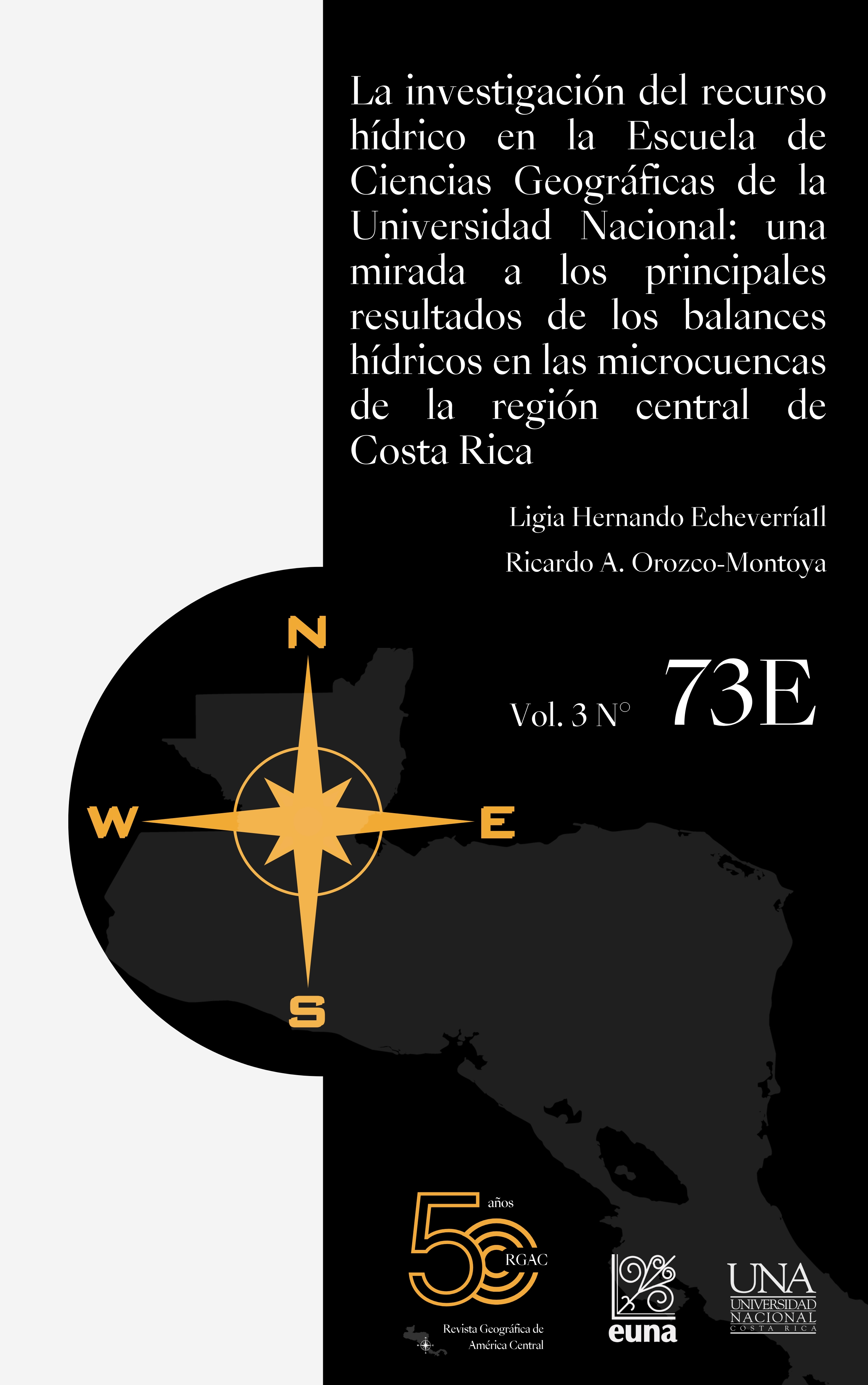Water Resource Research at the School of Geographic Sciences of the National University: An Overview of the Main Results of Water Balances in the Micro-Watersheds of the Central Region of Costa Rica
DOI:
https://doi.org/10.15359/rgac.73e-3.7Keywords:
balance hídrico, microcuencas, región centralAbstract
In Costa Rica, although water resources are abundant, certain areas face difficulties due to reduced availability for residents, leading to issues in supplying water for domestic and industrial use. The School of Geographic Sciences has actively addressed this issue. Since 2001, it has been quantifying water resources through the calculation of water balances in the micro-watersheds of the Poás, Ciruelas, Segundo, Bermúdez, Tibás, and Pará rivers. These studies have determined that the predominant availability is moderate, which suggests that it will soon become low. Therefore, it is urgent to implement proper management of the micro-watersheds to mitigate excessive water use.
References
Hernando-Echeverría, L. (2002). Proyecto Balance Hídrico de la Región Central de Costa Rica: el caso de la microcuenca del río Poás. Escuela de Ciencias Geográficas, Universidad Nacional, Costa Rica.
Hernando-Echeverría, L. (2004). Proyecto Balance Hídrico de la Región Central de Costa Rica: el caso de la microcuenca del río Ciruelas. Escuela de Ciencias Geográficas, Universidad Nacional, Costa Rica.
Hernando-Echeverría, L. (2010). Proyecto Balance Hídrico de la Región Central de Costa Rica: el caso de la microcuenca del río Segundo. Escuela de Ciencias Geográficas, Universidad Nacional, Costa Rica.
Hernando-Echeverría, L. (2015). Proyecto Balance Hídrico de la Región Central de Costa Rica: el caso de la microcuenca del río Tibás. Escuela de Ciencias Geográficas, Universidad Nacional, Costa Rica.
Hernando-Echeverría, L. (2017). Proyecto Balance Hídrico de la Región Central de Costa Rica: el caso de la microcuenca del río Pará. Escuela de Ciencias Geográficas, Universidad Nacional, Costa Rica.
Hernando-Echeverría, L; Orozco-Montoya, R. (2015). Disponibilidad del recurso hídrico en la microcuenca del río Bermúdez. Región Central de Costa Rica. Observatorio Medioambiental, 18, 165-181. https://doi.org/10.5209/rev_OBMD.2015.v18.51289
Hernando-Echeverría, L.; Orozco-Montoya, R. (2024). Proyecto Balance Hídrico de la Región Central de Costa Rica: el caso de la microcuenca del río Rosales. Escuela de Ciencias Geográficas, Universidad Nacional, Costa Rica.
Hernando-Echeverría, L.; Patterson, O.; Ruíz-Hernández, A.: Ramos, R.; Garro, L. (2002). Manejo y ordenamiento territorial de cuencas de Costa Rica. el caso de la microcuenca del río Poás. Revista Geográfica De América Central, 1(40), 101-111. https://www.revistas.una.ac.cr/index.php/geografica/article/view/1709
Hernando-Echeverría, L.; Ruíz-Hernández, A.; Solís-Zamora, K. (2012). Disponibilidad del recurso hídrico en la microcuenca del río Segundo. Región Central de Costa Rica. Revista Geográfica De América Central, 1(48), 117-132. https://www.revistas.una.ac.cr/index.php/geografica/article/view/4111
Instituto de Hidrología, Meteorología y Estudios Ambiental. (2004). Metodología para el cálculo de Índice de Escasez de Agua Superficial. Bogotá, D.C. IDEAM.
Marini, M.; Piccolo, M. (2000). El balance hídrico en la cuenca del río Quequén Salado, Argentina. Papeles de geografía, (31), 39-53.
Thornthwaite, C.; Mather, J. (1957). Instructions and tables for computing potential evapotranspiration and the water balance.

Published
How to Cite
Issue
Section
License
Copyright (c) 2024 Ligia Hernando Echeverría, Ricardo A. Orozco-Montoya

This work is licensed under a Creative Commons Attribution-NonCommercial-ShareAlike 4.0 International License.
Proposed policy for journals offering Open Access
Authors publishing their works in the Journal acknowledge and agree to the following terms:
a) Authors retain the copyrights to their works and guarantee the Journal the right to be the first to publish their works, under the Creative Commons License Attribution-NonCommercial-ShareAlike 4.0 International, CC BY-NC-SA 4.0 International (https://creativecommons.org/licenses/by-nc-sa/4.0/deed.es), which allows others to share works upon complying with the acknowledgment of authorship and mention of the Journal as the original publisher of the work.
b) Authors are permitted to separately establish additional agreements for the non-exclusive distribution of the official edition of the work published in the Journal (for example, authors may desire to place the work in an institutional repository or incorporate it into a book that is to published elsewhere) so long they acknowledgment to recognize the Journal as the original publisher. The aforementioned additional agreements must respect the terms of the non-profit character and sharing philosophy of the original license (CC BY-NC-SA 4.0 International, https://creativecommons.org/licenses/by-nc-sa/4.0/deed.es).
c) Authors are encouraged to archive the post-print or editor/PDF version in Open Access repositories.





 REVGEO is licensed under https://creativecommons.org/licenses/by-nc-sa/4.0/deed.es
REVGEO is licensed under https://creativecommons.org/licenses/by-nc-sa/4.0/deed.es
.svg_4.png)

_(1).png)
_(1)_(1)_(1)_1.png)
(2)(1)(1)(1).png)
